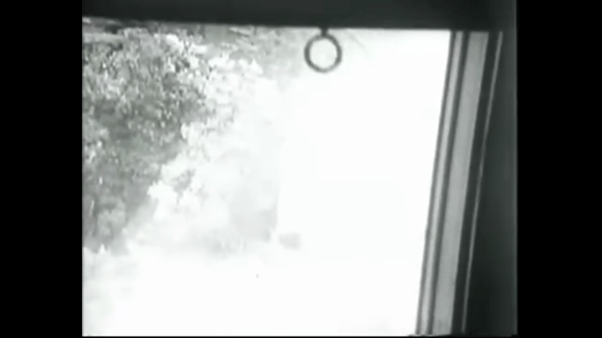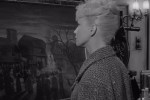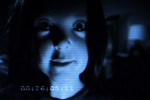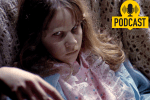Reece Goodall
At the turn of the 1990s, French director Jean-Teddy Filippe made a TV series unlike anything the nation had ever seen before. Les documents interdits (1989-1991, with a one-off special in 2010 to mark the 20th anniversary of the channel Arte) was a series of short films that purported to present genuine footage of unusual events: encounters with ghosts, aliens, and witches, murders, psychic powers, bionic engineering, and disappearances.1 The show codified many of the tropes and techniques of found footage long before the genre was widely established in contemporary cinema. Yet the show has been comparatively underdiscussed, despite Alexandra Heller-Nicholas positioning it as part of the ancestry of found footage, and her claim that the series ‘is so prophetic that it could be reasonably considered a basic road map for the direction the subgenre would take’ (2014, 82), the show has been comparatively underdiscussed. According to Filippe, the series was intended as a criticism of television culture, and one that demanded its viewers be attentive and think critically about the images they are consuming (Léo 2009). But it also boasts a prescient combination of unbelievable fantastic narratives, fused with de-dramatised and seemingly authentic amateur footage, which unknowingly laid the groundwork for a subgenre that was to emerge in force in the decades that followed. Les documents interdits was found footage before it was popular in the cinema. However, given the horror genre’s ability to depict and unearth moments of national trauma (and the specific formal capacity of found footage to do so in a way that troubles historical documentation and official narratives), I argue that Les documents interdits is also worthy of interrogation precisely because of the context in which it was made. As France reckoned with the realities of its World War II past, it is clear that the show can be read as a coded means of dealing with the lingering national trauma.
After the Occupation of France in World War II, a myth of resistance occurred, popularised by Charles de Gaulle: the idea that all of France had resisted the Germans (what the historian Henri Rousso famously called résistancialisme [1990]), and thus the darkness of the nation’s collaboration could be collectively and purposefully forgotten. At the end of the 1960s, and especially after de Gaulle’s death in 1970, a large number of books and films appeared seeking to address the reality of the war years, most famously Marcel Ophuls’ Le Chagrin et la pitié (1969) and Louis Malle’s controversial Lacombe, Lucien (1974). The war was certainly in the minds of the French people at the turn of the 1990s too, with political and social events keeping the memories alive and helping to restore those that had been deliberately forgotten. At the turn of the decade, Klaus Barbie, the so-called Butcher of Lyon, was arrested and tried for his involvement in the torture and deportation of hundreds of people as head of the local Gestapo. Elsewhere, a law (la Loi Gayssot) was passed in 1990 making it illegal to deny both that the Holocaust had taken place and the size of the atrocities.2 Thus, the socio-cultural climate in which Les documents interdits was first aired saw France truly engaging with its World War II role, and doing so in both the cultural and the socio-political spheres.
While, at first blush, a found footage TV series dealing with unexplained events may not seem to engage with the nation’s WWII history, it is clear on closer inspection that it speaks to this national trauma in subtle and coded ways. Visual media is capable of representing trauma because it can ‘transport images [that have been] repressed or denied by the social body’ (Kohne, Elm and Kabalek 2014, 9). Horror, in particular, is unique in its ability to ‘re-open national wounds that have been suppressed, overlooked or only superficially addressed’ (Blake 2012, 9). The relevancy of such a reading is clear to a France that was truly beginning to reckon with the reality of its WWII past, and the found footage form is a particularly useful lens to do so given that it necessarily invites questions regarding the representations of narratives and their authenticity.3 Whereas other cultural products at the time, such as Jacques Audiard’s Un Héros très discret (1996), invite commentary on this period through narratives explicitly linked to Vichy and liberated France, Les documents interdits instead offers a coded deconstruction that (through the audience engagement Filippe consciously demands) facilitates a subtle interrogation of the very structures of official documentation and the narratives they present.
A recurring theme of the show is people disappearing without explanation: a castaway in a lifeboat swims away to an unknown fate in ‘Le Naufragé’; one of the group in ‘Le Pique-nique’ suddenly vanishes after jumping from a cliff; and in ‘Le Soldat’, a US soldier follows two mysterious strangers into the sea. Similarly, the ultimate resolution of both ‘Les Plongeurs’ and ‘Les Fantômes’ involves members of the filmmaker’s parties going missing. The preoccupation with sudden, unexplained disappearances speaks to an interest in a political climate in which people could be vanished, and the implicit demand that such disappearances should be both documented and (hopefully) explained. Elsewhere, the scapegoating of the Hungarian immigrant Tibor Nagy and his continued encounters with government officials after alleging an alien abduction in ‘Le Fou de carrefour’ is clearly suggestive of the attitudes of the Nazis and collaborating French officials towards Eastern Europeans and Jewish people. Similarly, the need for a gifted child to flee after medical interrogation marks him out as different in ‘L’Enfant’ is evocative of similar narratives (the episode is set in Montreal, but thanks is attributed at the end to the German community, making them a part of the story). Medical experimentation is the narrative drive of ‘La Sibérie’ which, although it takes place in the middle of Cold War, still foregrounds the notion of war (as does ‘Le Soldat’, solely through its temporal setting in 1943 and the mention of the Sicily landings).
The WWII resonances speak to specific narrative structures as well as these general themes. In ‘La Sorcière’, a South American village is terrified after a house disappears, leaving only what appears to be an old woman (the witch of the title) sitting in a chair, covered by a shroud. The entire village comes to what used to be the house, and the villagers become increasingly agitated because they are unsure what is happening. One woman approaches the witch, at which point every villager is seemingly paralysed in what is attributed to the witch’s magic, but which also appears to be an act of collective hysteria. Eventually, the woman removes the shroud to reveal that the form of the witch has disappeared; she is an unseen presence who still exerts total control over the collective population through the fear she instills. The narrative resumes six months later, after a mining company has taken over and made clear that resistance by the villagers will not be tolerated; a militia rounds up the villagers and place them in the back of a truck to be removed from their homes, a development highly evocative of the fates of many people in those towns occupied by the Germans. Indeed, the very notion of an external force taking over the community speaks directly to anxieties over the impact of occupation.
‘Les Crown filment les Young’ follows an American amateur filmmaker, Herbert Crown, but the concerns of his film echo many of the actions of France in the 1940s. The opening two minutes of the episode are framing shots of Crown’s neighbours – he provides the narration, documenting their lives as his camera lingers on them and their houses, an act that qualifies as a subtle evocation of official and methodical documentation of the neighbourhood. We encounter the Youngs, and learn that a local resident named Maria Mendoza (notably a foreign name) has gone missing. Crown sees Young digging and burning things in his garden, and his filming from this point on becomes noticeably covert, with the bars of windows and foliage blocking parts of the frame; the narrator states that he was driven by a desire to remain unseen, and this level of neighbourly observation speaks to the fear of surveillance and denunciation that existed at the time. Although Crown suspects that Young is doing something nefarious, his own actions are muted because of the stigma of surveying his neighbour. It transpires that Young has murdered Maria. The Crowns and Mrs. Young discuss what has happened, and opt to re-cover the grave and engage in a process of collective forgetting to protect their community and their friends. Crown’s line, “we just tacitly agreed not to go down the end of the garden”, is a matter-of-fact description about the implicit need for the cover-up, but it is one that he qualifies by discussing his own shame and questioning how he could do such a thing. However, despite his own seeming contrition, he remains quiet about the murder until Mr. Young has died, only then allowing the official documents to reveal the reality of the situation. Much like contemporary France, narratives were buried and could only resurface as the parties involved in perpetuating them passed on. Similarly, and evoking the films and the TV shows that would interrogate the idea of résistancialisme, media (in the form of Crown’s camera and the overarching TV show) play an important role in facilitating the emergence of the truth.
The idea of neighbourly surveillance is also evoked in ‘Le Cas Ferguson’, in which an American investigative reporter explores an old manor house after receiving a tip on the At Once TV show’s phone line. This is a set-up that the host Henry Matthews describes as enabling members of the public to “bear testimony” or to “shed light on some particular event or situation that we agree should be exposed”, immediately foregrounding the power of media to document and uncover hidden truths, and subtly evoking the idea of individuals imparting secrets and knowledge to authority figures (the host is in a suit and is clearly a professional man, slightly suggestive of the Gestapo and wartime agents). The consequence of such a design is that the authorities are then in control of the stock of knowledge: “We are willing to go anywhere, we’re on the lookout for anything, and we show everything.” The reporter and his cameraman arrive at the house, and find it seemingly empty. They enter, the permission to do so granted by Matthews and the television network rather than the homeowner, indicating the pervasive power of the surveillant structures. He continues to investigate inside the house, and the technical equipment begins to break down the further they go. And, as is typical of this series, after the cameras cut out on the reporter, he and his film crew vanish, never to be seen again. It is revealed that a Mrs. Ferguson lived in the same house in the 1930s, and that she made a telephone call to the exterminators about a rat problem – the implication, Matthews directly tells the audience, is that a paranormal event occurred inside the house. In a turn-of-the-90s Gallic context, however, there are two other points of horror that retain specific local resonance: the concept of the past bleeding into the present, and the way that rats (with all the associated cultural stereotypes of sub-humanness) and extermination are linked to the disappearance. Thus, ‘Le Cas Ferguson’ finds its WWII references in notions of both surveillance and extermination.
There is a further level of significance, attached to the way that Les documents interdits troubles the very notion of official records and documents. Although Filippe wanted to force his viewers to interrogate their own relationship with viewing, the concept of forbidden and hidden histories becoming exposed is clearly a resonant one for the France of this period. That a number of the episodes (such as ‘L’Extra-terrestre’ and ‘La Sibérie’) are coded as government films and documents speaks to the ways that authorities can manipulate official records, choosing what to reveal or not to their populations. The concept of ‘documents interdits’ takes on two meanings as a result: it speaks to a time in which records were censored and manipulated by the authorities, creating a historic stock of forbidden documents at the time, and thus implies a level of authenticity to the unveiling of these new truths precisely because they were originally concealed. Although, in a French context, the emergent narrative of France’s role in the Second World War was simply reality without a romanticised nationalistic whitewash, the programme still demands that the viewers question narratives and their constructions.
Through representations of both unexplained disappearances and mysterious and paranormal events, Filippe created a series of short films that simultaneously functioned as a site for France to process its real role in the Second World War and to deconstruct the assumed connection between official narratives and truth. The director’s approach, using television to create high-impact, fantastical and supposedly genuine films which force the viewer to actively decode them, is one that is particularly striking in a socio-cultural climate in which the domestic audience was already interrogating myths of their own national past.
Notes
- The 2010 episode, ‘L’Examen’, sees an unnamed figure abduct a family man named Peter, who resides in West Berlin, and take his place, an act that leads to multiple murders.
- Jean-Marie Le Pen, leader of the far-right Front National party until 2011, was fined multiple times for breaking this law, most recently for describing concentration camp gas chambers as a ‘mere detail of history’. Le Pen and his politics would be evoked in numerous French horror films post-2000, most notably in the Nazi patriarch in Xavier Gens’ Frontière(s) (2007).
- Shellie McMurdo (2022) effectively demonstrates the link between national trauma and the found footage form in a US context.
Works Cited
Blake, Linnie. The Wounds of Nations: Horror Cinema, Historical Trauma and National Identity. Manchester University Press, 2012.
Heller-Nicholas, Alexandra. Found Footage Horror Films: Fear and the Appearance of Reality. McFarland, 2013.
Kohne, Julia B., Michael Elm, and Kobi Kabalek. The Horrors of Trauma in Cinema: Violence Void Visualization. Cambridge Scholars Publishing, 2014.
Léo. ‘Entretien avec Jean-Teddy Filippe.’ Cinétrange, 30 November 2009.
McMurdo, Shellie. Blood on the Lens: Trauma and Anxiety in American Found Footage Horror Cinema. Edinburgh University Press, 2022.
Rousso, Henry. Le Syndrome de Vichy de 1944 à nos jours. Éditions du Seuil, 1990.










